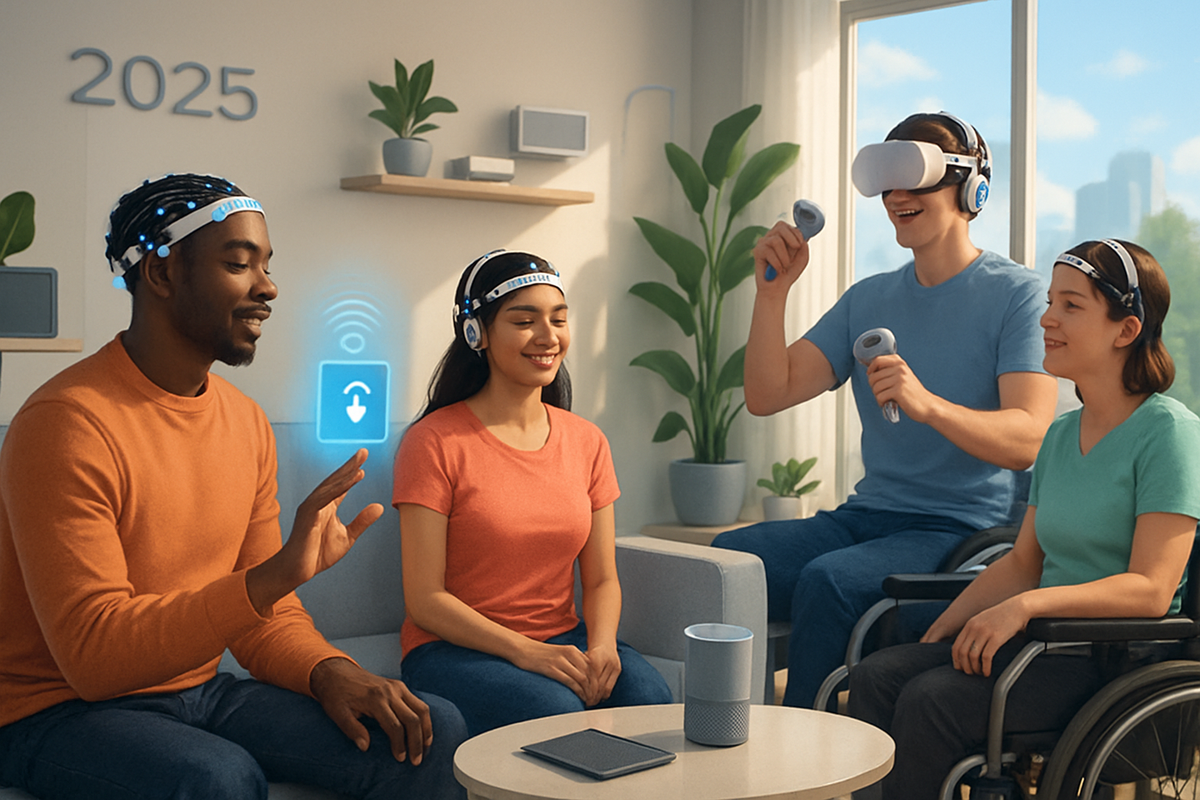Mind Over Machine: How Brain-Computer Interfaces and Neural Wearables Are Rewiring Daily Life in 2025
Step into the future where thought commands reality. Brain-computer interfaces transform lives, enabling hands-free communication and creativity. Are you ready to think your way into tomorrow's possibilities?

Welcome to the Mind-Machine Era
Imagine this: You think about opening your email—and your computer obeys. Your paralyzed neighbor texts you a joke, typed by sheer willpower. Kids scribble in thin air, their thoughts painting on screens. It’s not sci-fi. It’s 2025, and brain-computer interfaces (BCIs) and neural wearables are as real as your smartphone. The only question: Are you ready to think your way into tomorrow?
“The mind is its own place, and in itself can make a heaven of hell, a hell of heaven.”
— John Milton, updated for the age of Neuralink
From Sci-Fi to Selfies: The 2025 BCI & Neural Wearable Boom
Let’s cut through the hype: BCIs and neural wearables are no longer the stuff of TED Talks and dystopian thrillers. This year has seen:
- Neuralink’s first female patient writing her name on a screen using only her mind after 20 years of paralysis (Daily Mail, July 2025).
- Meta’s Reality Labs unveiling a wristband that detects your neuromuscular intent—think, and your avatar waves (ZDNet, July 2025).
- Apple and Amazon racing to integrate neural input with wearables, making accessibility a mainstream feature, not a footnote.
What’s changed? Miniaturization, machine learning, and a cosmic leap in ambition. The brain is the new touchscreen, and everyone from gamers to grandmas wants in.
How It Works: A Crash Course for Curious Minds
BCIs (like Neuralink) are tiny implants that read your brain’s electrical signals. They translate thought into action—no hands required. Neural wearables (think Meta’s wristband or Apple’s rumored neural ring) use sensors to capture the electrical whispers from your nerves and muscles, decoding intent before you even twitch.
In short: Your thoughts become commands. The world listens.
Hands-On: What’s It Like to Use a BCI or Neural Wearable?
- Typing & Browsing: Early Neuralink patients can move cursors, type text, and even play video games—just by thinking (Tekkix, July 2025).
- Gesture Control: Meta’s wristband lets you navigate AR worlds, control smart home devices, and sketch in midair. No more greasy fingerprints on your screen.
- Accessibility: For people with disabilities, these tools restore autonomy, enabling communication, work, and creativity once thought impossible.
Testers describe the experience as “magical,” “surreal,” and “shockingly intuitive.” But, as with all magic, it takes practice—and a pinch of patience.
Real-World Use Cases: Not Just for Cyborgs
1. Restoring Voices, Reclaiming Lives
Audrey Crews, paralyzed since 2005, wrote her name on a computer screen using Neuralink’s BCI. She’s one of seven trial patients now controlling devices, robots, and even playing Mario Kart—all with their thoughts.
2. Accessibility Goes Mainstream
Neural wearables are empowering people with ALS, spinal cord injuries, and other conditions to communicate and work independently. But the tech is also trickling into everyday life—think hands-free texting while cooking, or controlling your drone with a flick of your mind.
3. Gaming, Art, and the Next-Gen Metaverse
Gamers are controlling avatars with mere intention, artists are sketching with neural ink, and the metaverse is suddenly a lot less virtual. Expect mind-controlled VR sculpting and real-time collaboration that feels… telepathic.
The Accessibility Revolution
For millions, BCIs and neural wearables aren’t just cool—they’re life-changing. They promise:
- Communication for the voiceless
- Workplace inclusion for people with limited mobility
- Independence in daily living, from opening doors to sending emails
Meta, Apple, and Amazon are all touting accessibility as a core design principle. (Finally! Tech that doesn’t just “accommodate” but empowers.)
What Experts Are Saying
“We’re at a turning point. Brain-computer interfaces are not just for medical miracles—they’re about augmenting all of us. The challenge is making them safe, private, and equitable.”
— Dr. Lila Tran, Neurotechnology Ethicist
Engineers and clinicians agree: the tech is maturing fast, but questions remain about long-term safety, data privacy, and who gets access first.
The Big Questions: Ethics, Privacy, and Agency
Let’s get philosophical (don’t worry, we’ll keep it fun):
- Who owns your brain data? (Spoiler: Not always you.)
- Can your thoughts be hacked? (Researchers are working on encryption, but it’s early days.)
- Does mind control tech erode free will, or enhance it?
As we blend mind and machine, we must demand transparency, consent, and robust safeguards. Or as one ethicist put it: “Just because you can think it, doesn’t mean you should tweet it.”
What’s Next? The Road Ahead for Mind-Machine Tech
By 2030, experts predict:
- Non-invasive BCIs (no surgery required!) will be as common as smartwatches.
- AI co-pilots for your brain, filtering distractions and boosting focus.
- Universal design: Tech built for everyone, not just early adopters or the able-bodied.
But the real revolution? A society where everyone—regardless of ability—can shape reality with their thoughts. That’s a future worth thinking about.
Ready to Join the Conversation?
Like what you’re reading? Subscribe to Funaix for free and become a Funaix Insider! Only subscribers can write and read comments on our blog—so if you have thoughts (or mind-controlled robots), we want to hear from you. Did we mention it’s free—at least for now?
“The future is already here—it’s just not evenly distributed.”
— William Gibson, and every BCI user in 2025
Published: August 15, 2025 | For more smart news, guides, and the latest in mind-machine tech, subscribe here.




